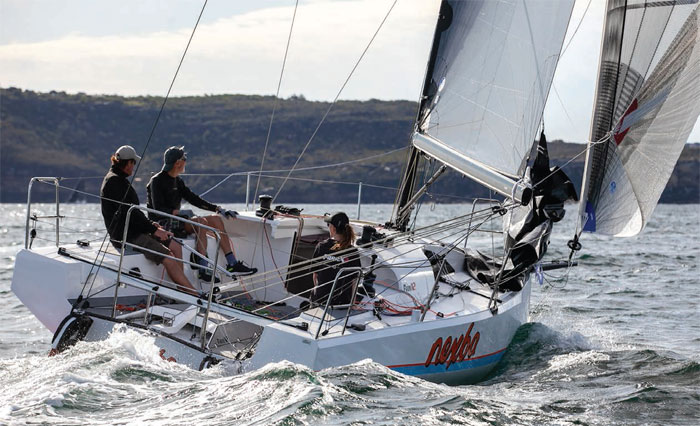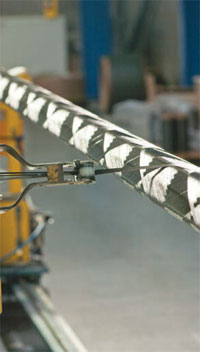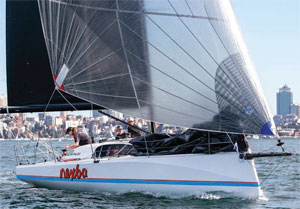

Seldén Mast continues to perfect the art of delivering fast lightweight carbon spars... and at accessible levels of cost
If there’s one area where the benefits of weight saving are frequently underestimated, it must surely be in the rig. When it comes to the additional performance-sapping inertia that is created when a boat is heeling or pitching, weight aloft has an exponential effect the further it is from the waterline. Rig experts Seldén know this well and like many other spar manufacturers they have invested considerably in carbon spar building technology to reduce weight aloft. But the gains go much further.
Seldén’ s starting point when compared with an equivalent alloy mast is a 30 per cent reduction in weight. But this is just the headline figure, refining the design can improve the savings considerably. And while the motivation to reduce weight is the same for all carbon spar builders, the Seldén approach to building carbon spars is significantly different and has been delivering impressive results.
‘We describe our process as mandrel filament moulding (MFM) in which we lay towpreg [preimpregnated fibre] around a male aluminium mandrel,’ explains Seldén’ s head of sales, Sam Vaughan. ‘We then put the tube into our autoclave where the laminate cures under pressure. The heat also causes the aluminium mandrel to expand, which achieves further compression on the laminate against the shrink wrap that we put around the tube before it goes into the autoclave. This ensures a great consolidation of laminate and a very low resin content at around 33 per cent. Once cured and out of the autoclave, the mandrel shrinks down and we pull it out from the cured tube with a big hydraulic ram.’
This single section method of construction provides a further advantage when it comes to joining tubes. ‘We can build single tubes up to 21m, beyond that a join is going to be required’ Vaughan continues. ‘But unlike our competitors, who have a front and back section that are joined either side along their entire length, our join is typically 600-700mm long for a 24m mast which offers a big weight saving.’ And while Seldén are justifiably proud of their production technique, they point to the accuracy, repeatability and reliability of the system as the three key benefits that place their spars apart from their competition.
‘Laying the towpreg onto the mandrel is computer controlled and is extremely accurate’ Vaughan says. ‘The machine will lay down fibres at certain orientations depending on the design of the tube. And while this is a very efficient and cost-effective way of building carbon tubes, the biggest advantages to many of our customers in the one design scene are the accuracy of build and the repeatability of the weight and bend characteristics of our spars.
‘A good example of that goes back to when we were developing the spars for a contender for the new women’s Olympic skiff class, the RS900. Here, consistency is one of the key criteria for any new Olympic one-design class. We built four rigs over a three to four-month period, all to the same specification and when they were bend tested the variance was just two per cent.
It’s not difficult to see why the accuracy and repeatability is appealing to one-design builders, but the process of using aluminium mandrels and filament winding also provides benefits to those in other areas of the sport.
‘When you consider a conventional aluminium mast the wall thickness and section shape is a constant and so you can end up with excess material where you don’t need it, making it hard to get the best mechanical properties throughout the length of the tube. But with MFM we can vary the amount of material and its fibre orientation to suit the structural requirements at any given position. So, we can have a really stiff lower section, softening out in the middle and then step it up in the top mast where there might be code sails, downwind sails or alternatively where there’s nothing at all other than the mainsail.

Above: Seldén’s unique mandrel filament moulding process is the key to producing a wide range of mast tubes with individually optimised bend properties.
‘This means that our stock mandrels, of which we have around 20, allow us to produce a wide range of optimised tubes. But we’ve also got another 50 drawn and ready to go for when specific projects require them. And while it costs to commission a new mandrel, it’s not like building a new section die for an alloy mast tube and having to commit to a minimum quantity of extrusions. We can be far more flexible in our approach which is appealing for our customers.’
One such example is a 30ft grand prix racer aimed at the shorthanded scene. Project manager Bret Perry was also the instigator of this exciting new design and has worked closely with Farr Yacht Design to ensure that this boat hits the spot from the word go. But he has also worked very closely with Seldén to create the perfect carbon spar package.
‘For starters you can’t undertake a project like this without partners that believe in the design, its concept and that see the potential. And while it’s not a technical answer as to why Seldén have been so good to work with, it’s been a huge part of this project,’ he says. ‘In addition, their ability to create a dedicated mast tube has meant that we’ve been able to create a rig that is specifically designed for shorthanded racing.
‘We went for intermediate modulus carbon fibre for the combination of weight, bend characteristics and stiffness, along with consistency. We also wanted a specific set up when it came to the standing rigging based on the sail plan which in turn placed certain technical and structural requirements on the design and construction of the mast.
‘One example of this is the setup for the standing rigging. We've gone for a cathedral type configuration where we've got a D3 and a cathedral V1. So, going from the top down we've got a single masthead spinnaker halyard at the top of the mast that is just for the A2. Then we have the Code Zero at about 15/16th, that is where the cathedral rig joins and also the backstays, so you're really controlling the luff tension on the Code Zero. And then moving down, the D3 effectively becomes the cap shroud when you load up the forestay. All of this has been driven by the need to make sure that we can handle the different potential sail plan configurations.
‘And then there’s the issue of reefing, which places additional demands on the mast. Our first reef is a big one because when you're shorthanded you'll often go straight to the second reef on a conventional rig. So this meant our configuration needed to be able to support that in a different sort of way.

‘If you’re on a boat where you need to fly the A2 in 25kts of breeze doublehanded on your third night at sea, the reality is it’s not going to be very comfortable, so you’ll want to get your furling sails out as soon as possible. We think we’ve achieved that with a boat that’s easily driven in say 27kts with a Code Zero on a deep safe angle. But to do this has only been possible through the considerable amount of effort and technical support that Seldén provided us with along with their ability to produce a tube that is specific to the needs of the X2.’
But while one-design and the shorthanded racing scenes have been big drivers for Seldén’s carbon spars, their work spreads much further across the sailing world.
‘From National 12s, Merlin Rockets, Contenders and other dinghy classes, right up to 75ft cruisers we use the same technology to build our carbon spars, but we can also offer a range of modulus fibres which some of our clients offer as upgrades,’ says Vaughan. ‘As standard we use T700 but we also do a lot of work with the intermediate modulus T800 which we believe delivers a great balance between mast building properties to weight and cost. In fact, that’s what the Farr X2 is constructed from. But we also build in high modulus HR40 and M40J and while this material can deliver a 30 per cent weight saving it is around 100 per cent more expensive so there’s a balance to be struck there.
‘But whatever the modulus we only use aerospace grade carbon, from Toray who supply Boeing and Airbus. This means we may be a little more expensive, but if Boeing and Airbus are using it, it’s good enough for us.’
Click here for more information on Seldén Mast »
We invite you to read on and find out for yourself why Seahorse is the most highly-rated source in the world for anyone who is serious about their racing.
To read on simply SIGN up NOW
Take advantage of our very best subscription offer or order a single copy of this issue of Seahorse.
Online at:
www.seahorse.co.uk/shop and use the code TECH20
Or for iPad simply download the Seahorse App at the iTunes store


